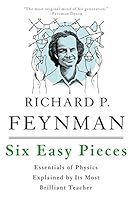# Six Easy Pieces

## Metadata
- Author: [[Richard P. Feynman, Robert B. Leighton, Matthew Sands]]
- Full Title: Six Easy Pieces
- Category: #books
## Highlights
- Six Easy Pieces grew out of the need to bring to as wide an audience as possible a substantial yet nontechnical physics primer based on the science of Richard Feynman. ([Location 70](https://readwise.io/to_kindle?action=open&asin=B004OVEYNU&location=70))
## New highlights added September 24, 2023 at 5:42 PM
- This means that when we compress a gas slowly, the temperature of the gas increases. So, under slow compression, a gas will increase in temperature, and under slow expansion it will decrease in temperature. ([Location 496](https://readwise.io/to_kindle?action=open&asin=B004OVEYNU&location=496))
## New highlights added June 20, 2024 at 1:21 AM
- The difference between solids and liquids is, then, that in a solid the atoms are arranged in some kind of an array, called a crystalline array, and they do not have a random position at long distances; the position of the atoms on one side of the crystal is determined by that of other atoms millions of atoms away on the other side of the crystal. ([Location 506](https://readwise.io/to_kindle?action=open&asin=B004OVEYNU&location=506))
- When the organization breaks down, these holes can be occupied by molecules. Most simple substances, with the exception of water and type metal, expand upon melting, because the atoms are closely packed in the solid crystal and upon melting need more room to jiggle around, but an open structure collapses, as in the case of water. ([Location 513](https://readwise.io/to_kindle?action=open&asin=B004OVEYNU&location=513))
- Helium, even at absolute zero, does not freeze, unless the pressure is made so great as to make the atoms squash together. If we increase the pressure, we can make it solidify. ([Location 524](https://readwise.io/to_kindle?action=open&asin=B004OVEYNU&location=524))
- When a molecule leaves it is due to an accidental, extra accumulation of a little bit more than ordinary energy, which it needs if it is to break away from the attractions of its neighbors. ([Location 550](https://readwise.io/to_kindle?action=open&asin=B004OVEYNU&location=550))
- An ion is an atom which either has a few extra electrons or has lost a few electrons. In a salt crystal we find chlorine ions (chlorine atoms with an extra electron) and sodium ions (sodium atoms with one electron missing). ([Location 565](https://readwise.io/to_kindle?action=open&asin=B004OVEYNU&location=565))
- In passing, we mention that the concept of a molecule of a substance is only approximate and exists only for a certain class of substances. It is clear in the case of water that the three atoms are actually stuck together. It is not so clear in the case of sodium chloride in the solid. There is just an arrangement of sodium and chlorine ions in a cubic pattern. There is no natural way to group them as “molecules of salt.” ([Location 580](https://readwise.io/to_kindle?action=open&asin=B004OVEYNU&location=580))
- But carbon attracts oxygen much more than oxygen attracts oxygen or carbon attracts carbon. Therefore in this process the oxygen may arrive with only a little energy, but the oxygen and carbon will snap together with a tremendous vengeance and commotion, and everything near them will pick up the energy. ([Location 601](https://readwise.io/to_kindle?action=open&asin=B004OVEYNU&location=601))